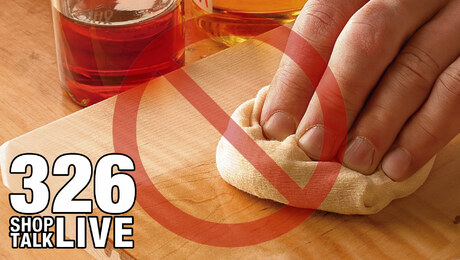STL 158: You see a chisel, he sees your soul
Plus, bandsaw tables, mitered shooting boards, smooth moves, philosophical woodworking questions, glass disk sharpening systems, and pencil vs. knifeShop Talk listeners, get $50 off your Fine Woodworking Live 2018 registration with the coupon code “SHOPTALK”
05:52 – Question 1:
How important is it to have an absolutely flat bandsaw table? I just bought a used 17”Minimax and discovered that the cast iron table isn’t flat. Is this likely to create a problem? If so, what’s the best fix? I’m hoping I didn’t just buy an expensive doorstop? – Jim
12:10 – Question 2:
I made Todd Crenshaw’s miter shooting board from issue #261. The idea is that the plane is tilted at 45 degrees away from the workpiece and the plane side rides on a wood runner. I know that on a regular shooting board, the first few passes typically leave a little ledge that the sole rides against. Sure enough, when I took my first few passes with this shooting board, it removed a little material from the shooting board. Unfortunately, now the plane won’t stay seated perfectly. With pressure toward the wood runner I can keep it 45 degrees but it’s kind of annoying. When I don’t apply pressure the plane wants to tilt toward the workpiece. Did I do something wrong, or is that just how this shooting board works? -Bradley
- A Shooting Board for Case Miters by Todd Crenshaw (Issue #261 – 2017)
- 4 Bench Jigs for Handplanes by Norman Pirollo #202–Tools & Shops 2009 Issue
- Shooting Boards Aim for Tight Joints by Michael Dunbar #144–Sept/Oct 2000 Issue
- Mitre Shooting Board by Tom Fidgen
18:00 – Smooth Move
35:36 – Question 3:
I’m just getting started in woodworking. I’m a bit confused about how I should mark dimensions and cuts. When do I use a marking knife versus a pencil? I see both used in fine woodworking, but I’ve never figured out why one is picked over the other. -Michael
- Layout: Pencil vs. Knife by Christian Becksvoort #179–Sept/Oct 2005 Issue
- Layout: When Pencil Beats Knife by Steve Brown #224–Jan/Feb 2012 Issue
50:08 – Philosophical Woodworking Question
1:02:20 – Question 4:
What do you think of glass disk sharpening systems such as the Worksharp 3000 and Veritas MKII Power Sharpener? I know you’re fans of waterstones, but this seems SO much easier! -Ken
Reader Comment
From Amy Costello @basicallyeverything.folio
I was just listening to STL#156, the question about sanding scratches in a turning. I’m also an only moderately skilled turner who still needs sandpaper, but luckily, I’ve had excellent instructors to help me on the way.
You guys were spot on about moving the paper a lot so you don’t get scratches from one bit of grit staying in place for too long, but Mike’s comment about sanding at the highest speed possible was a bit off. It’s ok to sand at high speeds when you’re in the low grits and you’re still trying to adjust the shape quickly, but once you’re ready to focus on smoothing the surface, it’s actually better to turn the lathe speed down. This is because, at really high lathe speeds, it’s difficult to move your sandpaper fast enough to prevent deep scratches from forming, just like they do if you hold the paper in one place for too long. The slower your lathe speed and the faster you move your sandpaper, the easier it is to create a random sanding pattern and to avoid creating deep scratches. I usually turn my lathe down gradually as I work through the grits, ending somewhere around 300-400 rpms when I get to 400 grit. If I’m sanding a really dense wood, I might go as high as 1200 grit at the same speed.
Just thought I’d throw my two cents in. You guys do great work!
-Amy Costello
 |
 |
 |
| Tom McKenna Editorial Director |
Mike Pekovich Creative Director |
Ben Strano Web Producer |
Every two weeks, a team of Fine Woodworking staffers answers questions from readers on Shop Talk Live, Fine Woodworking‘s biweekly podcast. Send your woodworking questions to [email protected] for consideration in the regular broadcast! Our continued existence relies upon listener support. So if you enjoy the show, be sure to leave us a five-star rating and maybe even a nice comment on our iTunes page.





















Comments
I purchased the Veritas MKII power sharpener a few years ago. Here are my thoughts:
Very much the amateur woodworker, I had never been able to get my edge tools remotely sharp. I had a guide and some waterstones, but probably didn't know what I was doing, nor what "sharp" really looked like. I'm also not that confident with a grinder in establishing the initial bevel.
With the MKII, my tools quickly and easily became noticeably sharper (still not sure if this is "sharp"). I started to use my chisels and planes regularly, and began to enjoy their use. For a sporadic woodworker, this was a huge step forward.
Over time, I've found a few drawbacks with the MKII that deserve mentioning (not including the definition of "sharp" which I'm in no position to comment on.)
1 - The outside of the discs spin faster than the inside! (no kidding...). This has started to cause problems with my plane blades, as the bevels are not established evenly across the edge, but instead are skewed towards the outside of the sharpening plate. I think makes it difficult to get the blade square into the plane body. This isn't really an issue with smaller chisels.
2 - replacing the sticky-back sandpaper can be extremely difficult. I've found the glue to be very strong, and if you grab the worn sheet with vicegrips to get grip, you'll frequently tear the sheets.
3 - I can get a pretty good polish on the back of my plane blades, but I can't flatten the back of my chisels the way I should, for reasons that Ben mentioned in the podcast.
Moving forward, I'm hesitant to invest even more money into more sharpening equipment. I'll probably use the sandpaper method to get my initial bevels, and then do a quick final honing on the MKII, as it still works well for that.
Your #1 is right on. I wanted to mention it, but in the moment forgot to. I think this is one of my biggest problems with this style of sharpener in general. I still think it's a good system, it's not the magic solution some are looking for.
I know what you can make with all those scraps!
https://www.finewoodworking.com/readerproject/2018/03/01/a-ludic-wood-collection
;o)
It’s a really simple and fun project and it’s a really great way to teach abou wood. In the article on the gallery I mentioned it been good for kids, but playing it with my 89 year old grandma was super fun.
After seeing that the drill press table distortion appears to correlate to the blade slot, then hearing that it might have been dropped (bent) in the past, my immediate reaction was to clamp both ends of the table to a block of oak spanning the width of the surface with a third clamp at the slot to determine if it could be pulled (i.e.gently) back back into plane. If so, pinning the alignment hole (or tapping a slightly bigger one into both surfaces might stablilize the table top. If the top breaks in half it would be closer to door-stop size or easier to tie on for an anchor, whichever is needed most.
While the comment by user6812261 are, I believe, directed toward the Worksharp, and not the Veritas MKII, they are spot on. The disk cuts faster toward the perimeter than the center. This makes producing an edge perfectly perpendicular to the tool axis all but impossible.
I have one, but switched to water stones and a MKII for this reason. BTW, it's not a good grinder for the same reason.
This is in reference to user-6812261’s comments of the shortcomings of the Veritas Mark ll power sharpener submitted on March 2 2018 and to the comments, in general, by the staff on Shop Talk Live No. 158.
I am also an amateur sharpener and have felt some frustration in this field; hence the use of power tools almost exclusively thus avoiding as much sharpening as possible. Yes, avoidance has been my go- to method in woodworking. However, in the desire to really enjoy the full woodworking experience I knew that hand tools were going to play a major role and that would require sharp tools.
After several tiring and frustrating methods attempted overtime, I finally settled on the Worksharp 3000, the Norton water stones, and the Lie-Nielsen honing guide. I finally found sharpening heaven! I use the Worksharp to get the general bevel requiring very little time. The insert guide for the tool is pretty accurate and a time saver; higher grade sandpaper minimizes the scratch pattern and imparts a polished surface. However, the final finishing is always completed with the water stones using the Lie-Nielsen honing guide. This process produces excellent results which makes me a happy camper. Surprisely, I actually found my Zen in sharpening.
Now, in regards to user-6812261’s comment concerning the difficulty of removing the disc sandpaper; I just soak the disc in warm soapy water while doing other tasks. The inherent situation of uneven micro bevels is corrected by tool movement.
In respects to the rounding off in flatting the back of the tool, I have not experience this problem. The concern over cost of sandpaper isn’t an issue as I adapt quality but less expensive product sources. I am able to do the roughing and semi-finishing several times before considering replacement. In some cases I can use a worn grade as a finer grade as a resource management tool (to an extent).
As far as over-all base costs: The Workshop is $200.00; Norton water stones, consisting of a 1000, 4000, and 8000 grit stones totaling $125.00 and for my specific choice, the basic Lie-Nielsen honing guide sells at $125.00; we are looking at a minimum cost of $450.00. As a comparison, your basic Veritas Mark ll power sharpener has a base cost of $380.00, a Lie-Nielsen No. 4 smoothing plane goes for 350.00, and a happy wife is priceless (happy woodworker equals happy wife).
So, the costs are in line with other quality items (minus the wife of course) and well worth the investment (including the wife). Thanks for the Shop Talk Live; it enriches one’s life and enjoyment.
Philosophical Woodworking Question
I really enjoyed this question. It sent me back in time to when I read James Krenov's "The Impractical Cabinetmaker" It started me on my journey as a fine woodworker. Many years later I am still learning and enjoying my time in the shop, with occasional moments of "I suck at this". I had the good fortune to attend a lecture by Mr. Krenov at the College of the Redwoods. The most memorable quote from the lecture is "One should never walk away from an encounter with a piece furniture bloody."
Thank you for the podcast and I am looking forward to many more.Cheers, Mike
No mention of Amy Costello in the show notes? I thought her comments were excellent. (I checked the show notes for 156 as well).
You're right! My bad. Fixing that now.
Log in or create an account to post a comment.
Sign up Log in